Attached files
| file | filename |
|---|---|
| 8-K - FORM 8-K - DTE Electric Co | c20494e8vk.htm |
| EX-99.2 - EX-99.2 - DTE Electric Co | c20494exv99w2.htm |
| EX-99.1 - EX-99.1 - DTE Electric Co | c20494exv99w1.htm |
Exhibit 99.3
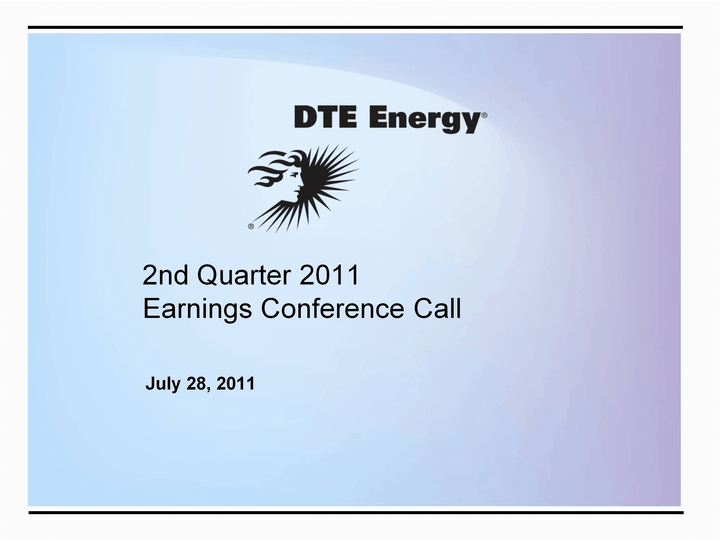
| 2nd Quarter 2011 Earnings Conference Call July 28, 2011 |
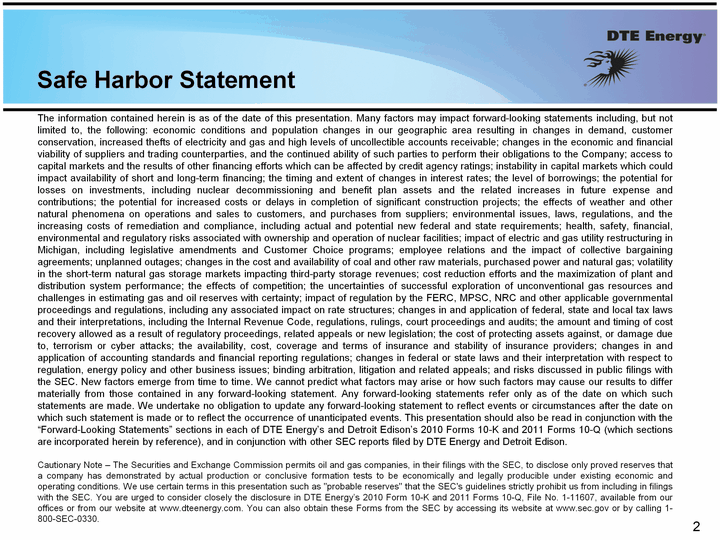
| Safe Harbor Statement The information contained herein is as of the date of this presentation. Many factors may impact forward-looking statements including, but not limited to, the following: economic conditions and population changes in our geographic area resulting in changes in demand, customer conservation, increased thefts of electricity and gas and high levels of uncollectible accounts receivable; changes in the economic and financial viability of suppliers and trading counterparties, and the continued ability of such parties to perform their obligations to the Company; access to capital markets and the results of other financing efforts which can be affected by credit agency ratings; instability in capital markets which could impact availability of short and long-term financing; the timing and extent of changes in interest rates; the level of borrowings; the potential for losses on investments, including nuclear decommissioning and benefit plan assets and the related increases in future expense and contributions; the potential for increased costs or delays in completion of significant construction projects; the effects of weather and other natural phenomena on operations and sales to customers, and purchases from suppliers; environmental issues, laws, regulations, and the increasing costs of remediation and compliance, including actual and potential new federal and state requirements; health, safety, financial, environmental and regulatory risks associated with ownership and operation of nuclear facilities; impact of electric and gas utility restructuring in Michigan, including legislative amendments and Customer Choice programs; employee relations and the impact of collective bargaining agreements; unplanned outages; changes in the cost and availability of coal and other raw materials, purchased power and natural gas; volatility in the short-term natural gas storage markets impacting third-party storage revenues; cost reduction efforts and the maximization of plant and distribution system performance; the effects of competition; the uncertainties of successful exploration of unconventional gas resources and challenges in estimating gas and oil reserves with certainty; impact of regulation by the FERC, MPSC, NRC and other applicable governmental proceedings and regulations, including any associated impact on rate structures; changes in and application of federal, state and local tax laws and their interpretations, including the Internal Revenue Code, regulations, rulings, court proceedings and audits; the amount and timing of cost recovery allowed as a result of regulatory proceedings, related appeals or new legislation; the cost of protecting assets against, or damage due to, terrorism or cyber attacks; the availability, cost, coverage and terms of insurance and stability of insurance providers; changes in and application of accounting standards and financial reporting regulations; changes in federal or state laws and their interpretation with respect to regulation, energy policy and other business issues; binding arbitration, litigation and related appeals; and risks discussed in public filings with the SEC. New factors emerge from time to time. We cannot predict what factors may arise or how such factors may cause our results to differ materially from those contained in any forward-looking statement. Any forward-looking statements refer only as of the date on which such statements are made. We undertake no obligation to update any forward-looking statement to reflect events or circumstances after the date on which such statement is made or to reflect the occurrence of unanticipated events. This presentation should also be read in conjunction with the "Forward-Looking Statements" sections in each of DTE Energy's and Detroit Edison's 2010 Forms 10-K and 2011 Forms 10-Q (which sections are incorporated herein by reference), and in conjunction with other SEC reports filed by DTE Energy and Detroit Edison. Cautionary Note - The Securities and Exchange Commission permits oil and gas companies, in their filings with the SEC, to disclose only proved reserves that a company has demonstrated by actual production or conclusive formation tests to be economically and legally producible under existing economic and operating conditions. We use certain terms in this presentation such as "probable reserves" that the SEC's guidelines strictly prohibit us from including in filings with the SEC. You are urged to consider closely the disclosure in DTE Energy's 2010 Form 10-K and 2011 Forms 10-Q, File No. 1-11607, available from our offices or from our website at www.dteenergy.com. You can also obtain these Forms from the SEC by accessing its website at www.sec.gov or by calling 1- 800-SEC-0330. 2 |
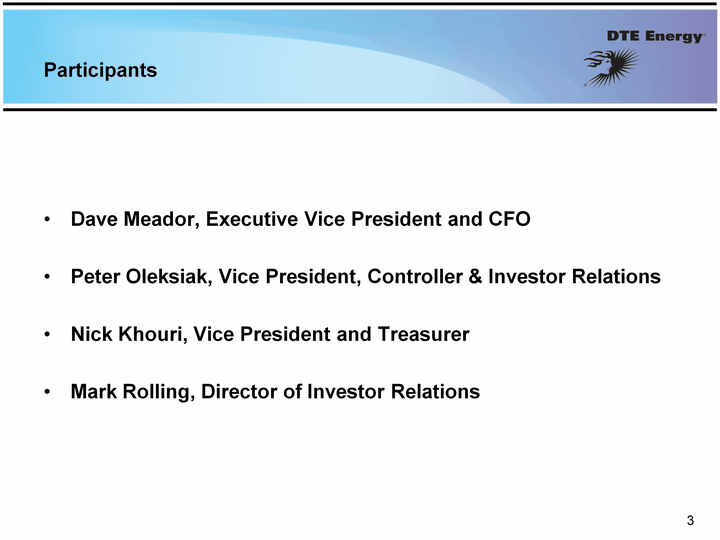
| 3 Participants Dave Meador, Executive Vice President and CFO Peter Oleksiak, Vice President, Controller & Investor Relations Nick Khouri, Vice President and Treasurer Mark Rolling, Director of Investor Relations |
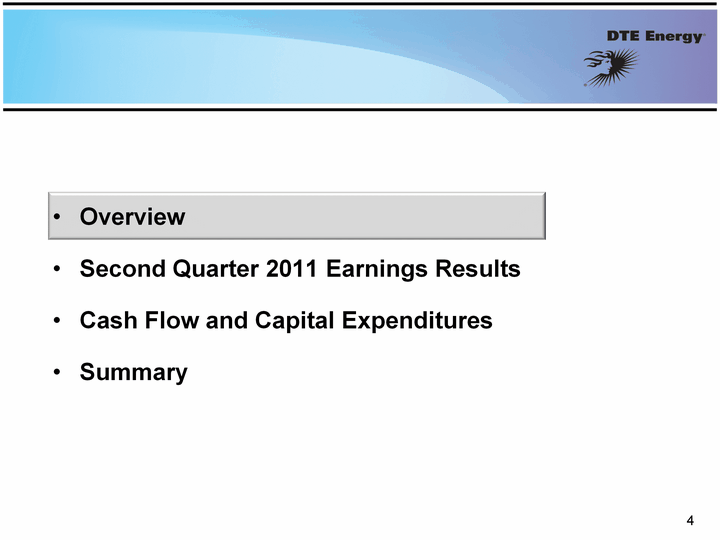
| 4 Overview Second Quarter 2011 Earnings Results Cash Flow and Capital Expenditures Summary |
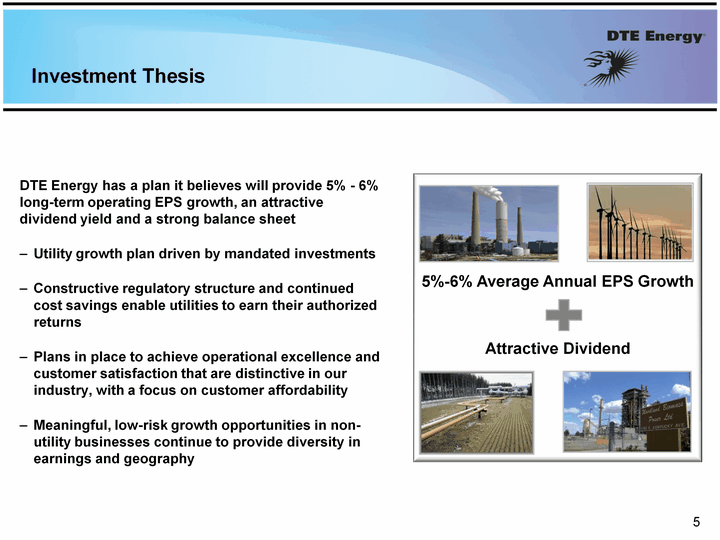
| Investment Thesis DTE Energy has a plan it believes will provide 5% - 6% long-term operating EPS growth, an attractive dividend yield and a strong balance sheet Utility growth plan driven by mandated investments Constructive regulatory structure and continued cost savings enable utilities to earn their authorized returns Plans in place to achieve operational excellence and customer satisfaction that are distinctive in our industry, with a focus on customer affordability Meaningful, low-risk growth opportunities in non- utility businesses continue to provide diversity in earnings and geography 5%-6% Average Annual EPS Growth Attractive Dividend 5 |
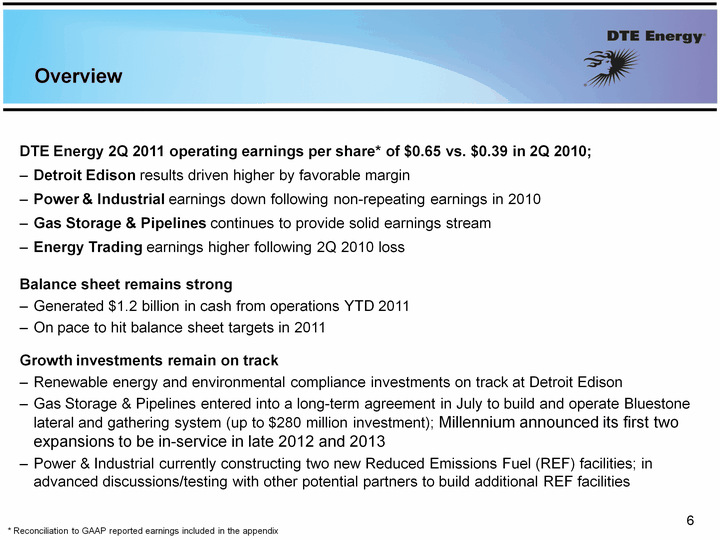
| Overview 6 * Reconciliation to GAAP reported earnings included in the appendix DTE Energy 2Q 2011 operating earnings per share* of $0.65 vs. $0.39 in 2Q 2010; Detroit Edison results driven higher by favorable margin Power & Industrial earnings down following non-repeating earnings in 2010 Gas Storage & Pipelines continues to provide solid earnings stream Energy Trading earnings higher following 2Q 2010 loss Balance sheet remains strong Generated $1.2 billion in cash from operations YTD 2011 On pace to hit balance sheet targets in 2011 Growth investments remain on track Renewable energy and environmental compliance investments on track at Detroit Edison Gas Storage & Pipelines entered into a long-term agreement in July to build and operate Bluestone lateral and gathering system (up to $280 million investment); Millennium announced its first two expansions to be in-service in late 2012 and 2013 Power & Industrial currently constructing two new Reduced Emissions Fuel (REF) facilities; in advanced discussions/testing with other potential partners to build additional REF facilities |
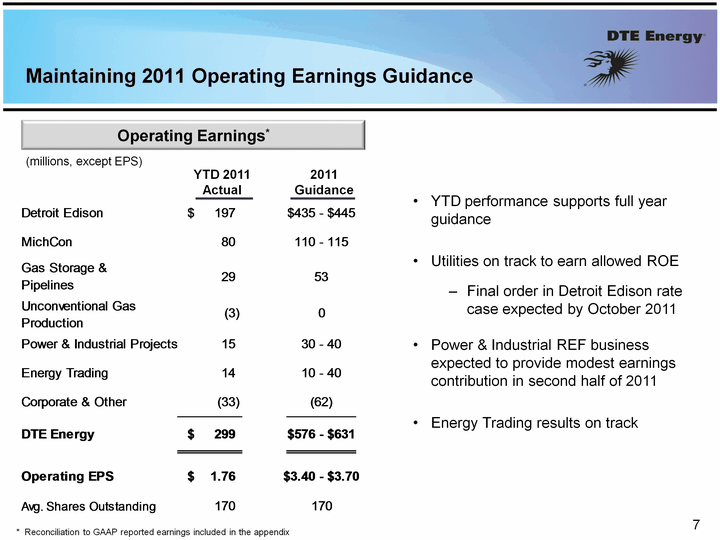
| * Reconciliation to GAAP reported earnings included in the appendix 7 Maintaining 2011 Operating Earnings Guidance YTD performance supports full year guidance Utilities on track to earn allowed ROE Final order in Detroit Edison rate case expected by October 2011 Power & Industrial REF business expected to provide modest earnings contribution in second half of 2011 Energy Trading results on track YTD 2011 Actual 2011 Guidance Operating Earnings* (millions, except EPS) |
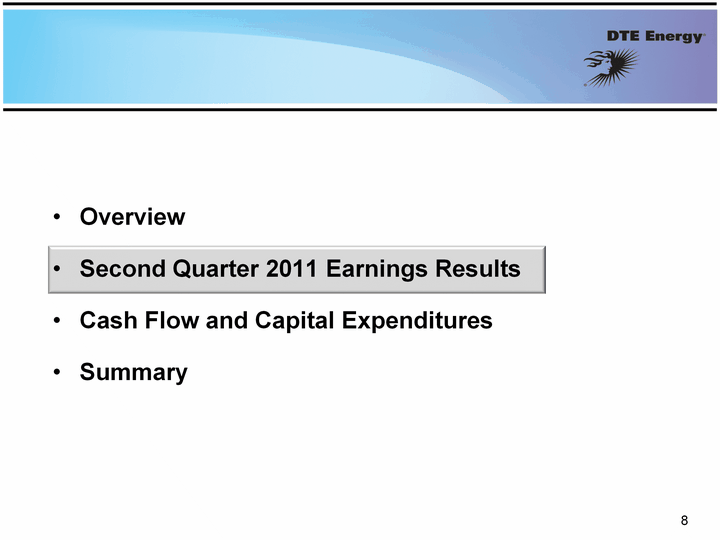
| 8 Overview Second Quarter 2011 Earnings Results Cash Flow and Capital Expenditures Summary |
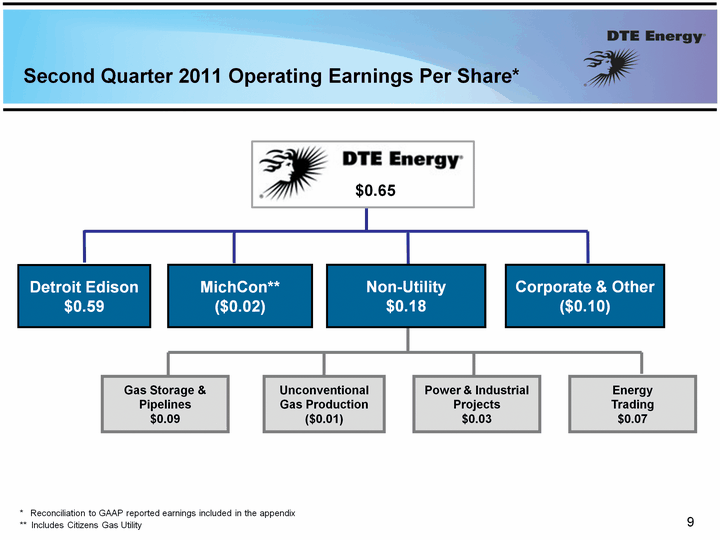
| Second Quarter 2011 Operating Earnings Per Share* Detroit Edison $0.59 Unconventional Gas Production ($0.01) Non-Utility $0.18 Gas Storage & Pipelines $0.09 Corporate & Other ($0.10) MichCon** ($0.02) $0.65 Power & Industrial Projects $0.03 * Reconciliation to GAAP reported earnings included in the appendix ** Includes Citizens Gas Utility Energy Trading $0.07 9 |

| 10 Second Quarter 2011 Operating Earnings Variance Favorability due to self-implemented rates in 2Q 2011 * Reconciliation to GAAP reported earnings included in the appendix Detroit Edison MichCon Final rates lower than self-implemented rates and lower storage revenues partially offset by favorable weather Operating Earnings* (millions, except EPS) 2Q 2011 2Q 2010 Change Non-Utility Power & Industrial lower due to non- repeating 2010 earnings Energy Trading higher due to favorable timing and improved economic performance Corporate & Other favorability driven by lower interest and taxes in 2011 Drivers |
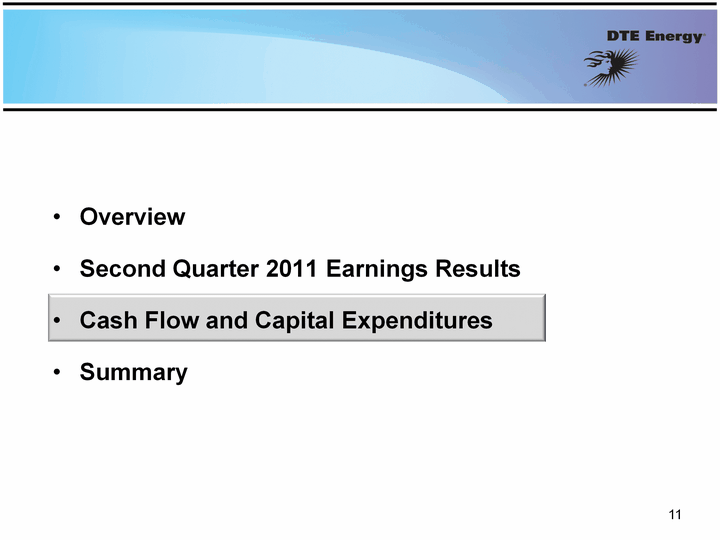
| 11 Overview Second Quarter 2011 Earnings Results Cash Flow and Capital Expenditures Summary |

| (CHART) 12 *Debt excludes securitization, a portion of MichCon's short-term debt, and considers 50% of the trust preferreds as equity Targeted Financial Metrics A strong balance sheet continues to be a key priority Leverage and cash flow metrics within targeted ranges, without additional equity in 2011 $1.7 billion of available liquidity at end of 2Q 2011 Recent financings In May, Detroit Edison issued $250 million of 10-year bonds with a 3.90% coupon Also in May, DTE Energy issued $300 million of 2-year floating rate debt to pay a portion of $600 million of maturing debt Leverage* Funds from Operations / Debt* (CHART) 51% 51% Target 50% - 52% 28% 23% Target 22% - 24% 53% 22% |
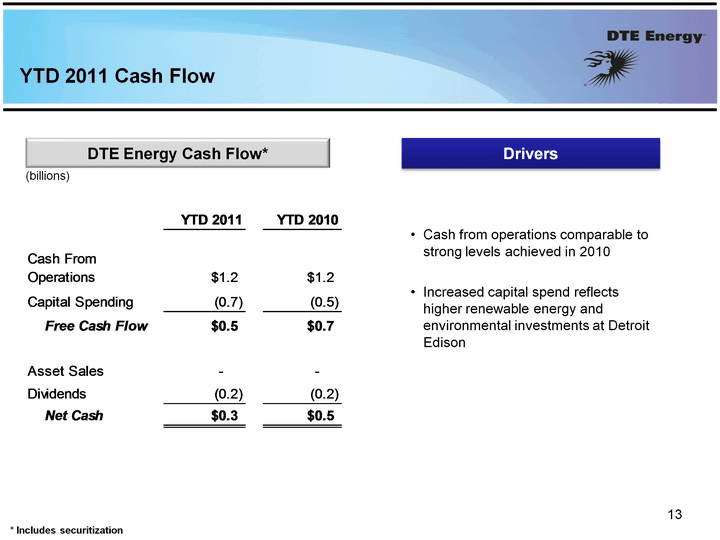
| 13 YTD 2011 Cash Flow DTE Energy Cash Flow* (billions) Drivers Cash from operations comparable to strong levels achieved in 2010 Increased capital spend reflects higher renewable energy and environmental investments at Detroit Edison * Includes securitization |

| 14 YTD 2011 Capital Expenditures DTE Energy Capital Expenditures (millions) Detroit Edison primarily driven by increased spending on wind projects and higher environmental spend at Monroe Power Plant MichCon spending increased due to mainline renewal and meter relocation projects Non-utility spending is consistent year over year Drivers |
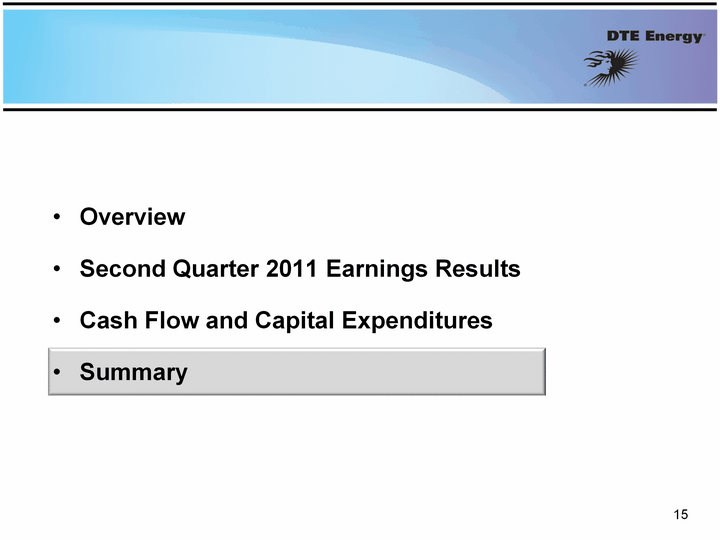
| 15 Overview Second Quarter 2011 Earnings Results Cash Flow and Capital Expenditures Summary |
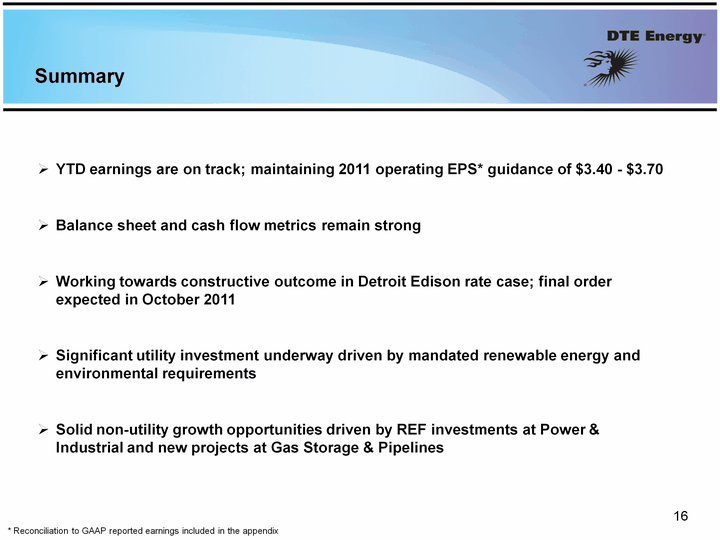
| Summary 16 * Reconciliation to GAAP reported earnings included in the appendix YTD earnings are on track; maintaining 2011 operating EPS* guidance of $3.40 - $3.70 Balance sheet and cash flow metrics remain strong Working towards constructive outcome in Detroit Edison rate case; final order expected in October 2011 Significant utility investment underway driven by mandated renewable energy and environmental requirements Solid non-utility growth opportunities driven by REF investments at Power & Industrial and new projects at Gas Storage & Pipelines |
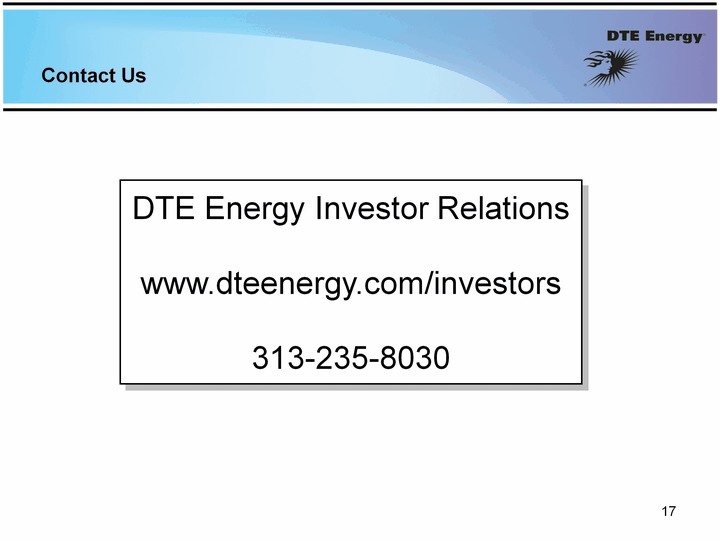
| 17 Contact Us DTE Energy Investor Relations www.dteenergy.com/investors 313-235-8030 |

| Appendix |
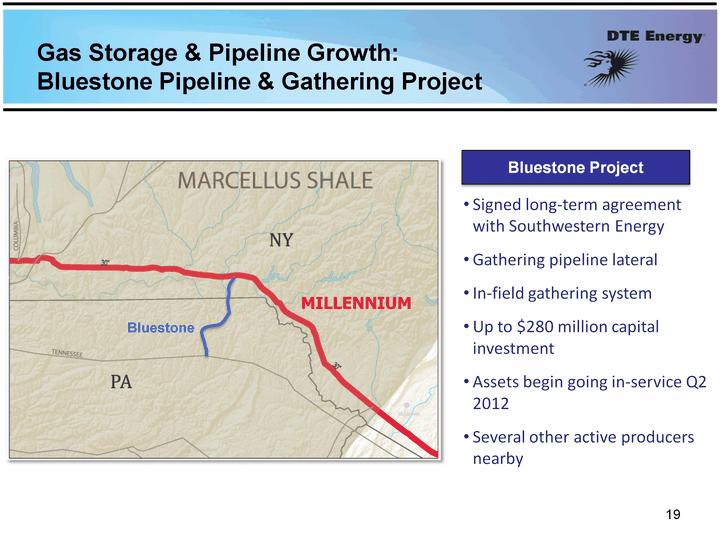
| 19 Gas Storage & Pipeline Growth: Bluestone Pipeline & Gathering Project Bluestone Project Bluestone Signed long-term agreement with Southwestern Energy Gathering pipeline lateral In-field gathering system Up to $280 million capital investment Assets begin going in-service Q2 2012 Several other active producers nearby |
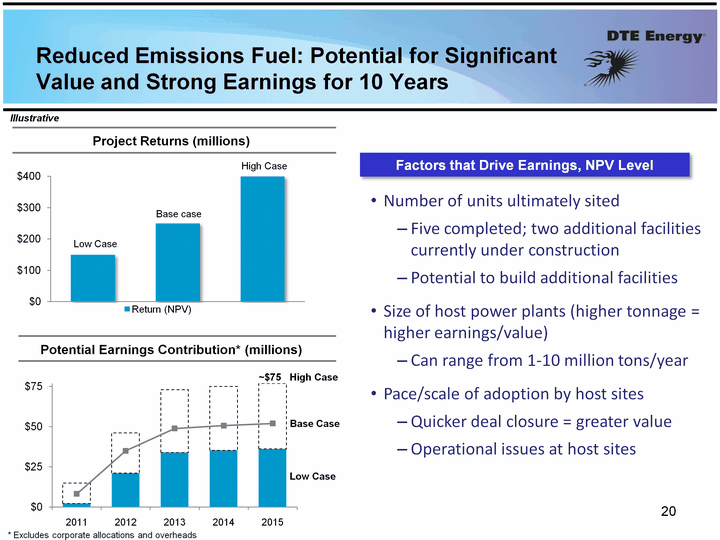
| 20 Factors that Drive Earnings, NPV Level Number of units ultimately sited Five completed; two additional facilities currently under construction Potential to build additional facilities Size of host power plants (higher tonnage = higher earnings/value) Can range from 1-10 million tons/year Pace/scale of adoption by host sites Quicker deal closure = greater value Operational issues at host sites (CHART) (CHART) Low Case High Case Project Returns (millions) Potential Earnings Contribution* (millions) * Excludes corporate allocations and overheads Low Case High Case ~$75 Base Case Base case Illustrative Reduced Emissions Fuel: Potential for Significant Value and Strong Earnings for 10 Years |

| 21 2011 Capital Expenditures & Cash Flow Guidance Capital Expenditures (millions) Cash Flow Summary* (billions) * Includes securitization |
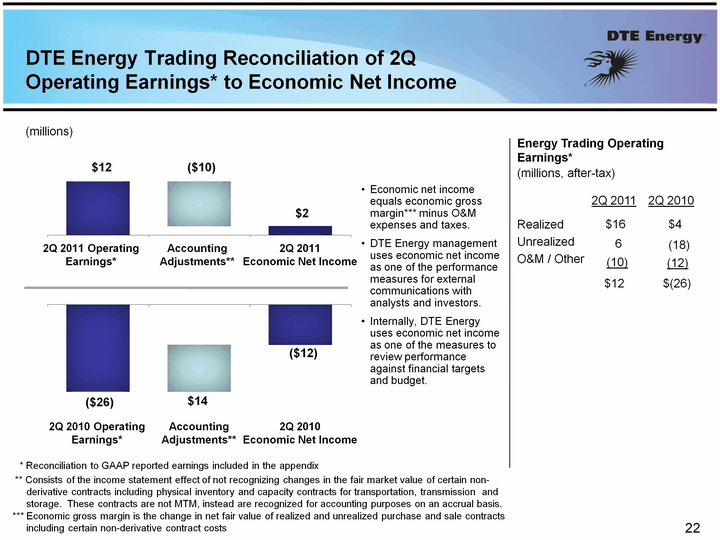
| (CHART) (CHART) DTE Energy Trading Reconciliation of 2Q Operating Earnings* to Economic Net Income ** Consists of the income statement effect of not recognizing changes in the fair market value of certain non- derivative contracts including physical inventory and capacity contracts for transportation, transmission and storage. These contracts are not MTM, instead are recognized for accounting purposes on an accrual basis. (millions) 2Q 2011 Economic Net Income Accounting Adjustments** 2Q 2011 Operating Earnings* ($10) $2 Economic net income equals economic gross margin*** minus O&M expenses and taxes. DTE Energy management uses economic net income as one of the performance measures for external communications with analysts and investors. Internally, DTE Energy uses economic net income as one of the measures to review performance against financial targets and budget. * Reconciliation to GAAP reported earnings included in the appendix *** Economic gross margin is the change in net fair value of realized and unrealized purchase and sale contracts including certain non-derivative contract costs Energy Trading Operating Earnings* Realized Unrealized O&M / Other 2Q 2010 2Q 2011 $4 $16 6 (18) (12) (10) (millions, after-tax) $(26) $12 ($12) 2Q 2010 Operating Earnings* 2Q 2010 Economic Net Income Accounting Adjustments** 22 $12 ($26) |

| (CHART) DTE Energy Trading Reconciliation of YTD Operating Earnings* to Economic Net Income ** Consists of the income statement effect of not recognizing changes in the fair market value of certain non- derivative contracts including physical inventory and capacity contracts for transportation, transmission and storage. These contracts are not MTM, instead are recognized for accounting purposes on an accrual basis. (millions) YTD 2011 Economic Net Income Accounting Adjustments** YTD 2011 Operating Earnings* $12 $26 Economic net income equals economic gross margin*** minus O&M expenses and taxes. DTE Energy management uses economic net income as one of the performance measures for external communications with analysts and investors. Internally, DTE Energy uses economic net income as one of the measures to review performance against financial targets and budget. * Reconciliation to GAAP reported earnings included in the appendix *** Economic gross margin is the change in net fair value of realized and unrealized purchase and sale contracts including certain non-derivative contract costs Energy Trading Operating Earnings* Realized Unrealized O&M / Other YTD 2010 YTD 2011 $21 $30 8 19 (28) (24) (millions, after-tax) $12 $14 (CHART) $12 $18 $30 YTD 2010 Operating Earnings* YTD 2010 Economic Net Income Accounting Adjustments** 23 $14 |
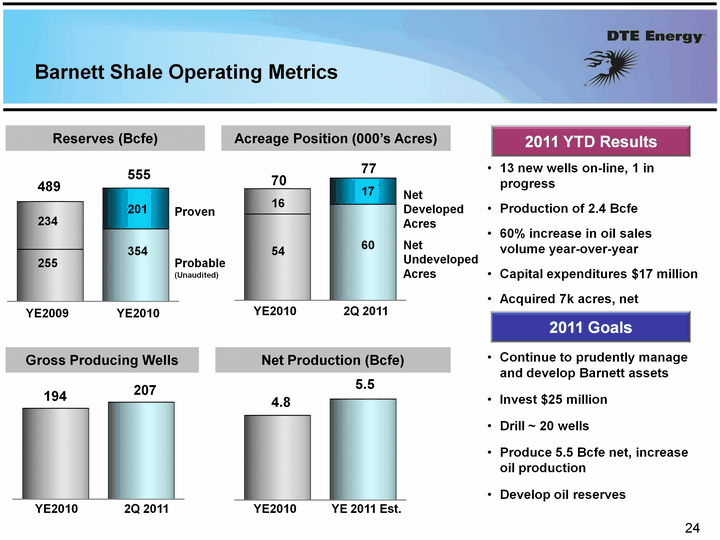
| (CHART) (CHART) (CHART) Net Production (Bcfe) Gross Producing Wells 207 Reserves (Bcfe) Acreage Position (000's Acres) Net Undeveloped Acres Net Developed Acres Barnett Shale Operating Metrics 17 2Q 2011 60 77 16 54 YE2010 70 2Q 2011 YE2010 194 5.5 YE2010 4.8 (CHART) YE2010 YE2009 Probable (Unaudited) Proven 354 201 555 255 234 489 Continue to prudently manage and develop Barnett assets Invest $25 million Drill ~ 20 wells Produce 5.5 Bcfe net, increase oil production Develop oil reserves 13 new wells on-line, 1 in progress Production of 2.4 Bcfe 60% increase in oil sales volume year-over-year Capital expenditures $17 million Acquired 7k acres, net 2011 YTD Results 2011 Goals YE 2011 Est. 24 |

| 25 Use of Operating Earnings Information - DTE Energy management believes that operating earnings provide a more meaningful representation of the company's earnings from ongoing operations and uses operating earnings as the primary performance measurement for external communications with analysts and investors. Internally, DTE Energy uses operating earnings to measure performance against budget and to report to the Board of Directors. Reconciliation of 2Q 2011 Reported to Operating Earnings |
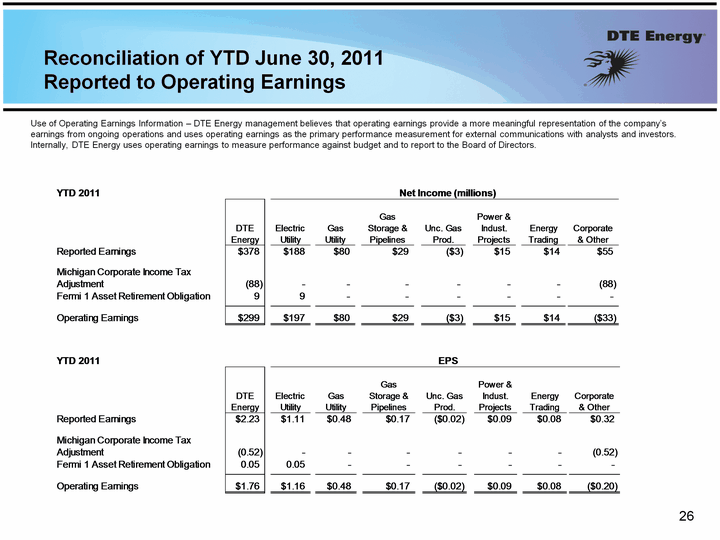
| 26 Use of Operating Earnings Information - DTE Energy management believes that operating earnings provide a more meaningful representation of the company's earnings from ongoing operations and uses operating earnings as the primary performance measurement for external communications with analysts and investors. Internally, DTE Energy uses operating earnings to measure performance against budget and to report to the Board of Directors. Reconciliation of YTD June 30, 2011 Reported to Operating Earnings |
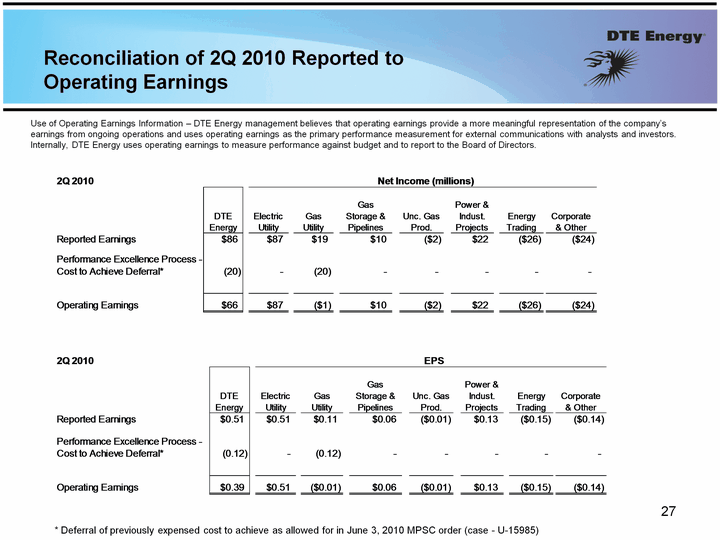
| 27 Use of Operating Earnings Information - DTE Energy management believes that operating earnings provide a more meaningful representation of the company's earnings from ongoing operations and uses operating earnings as the primary performance measurement for external communications with analysts and investors. Internally, DTE Energy uses operating earnings to measure performance against budget and to report to the Board of Directors. Reconciliation of 2Q 2010 Reported to Operating Earnings * Deferral of previously expensed cost to achieve as allowed for in June 3, 2010 MPSC order (case - U-15985) |

| 28 Use of Operating Earnings Information - DTE Energy management believes that operating earnings provide a more meaningful representation of the company's earnings from ongoing operations and uses operating earnings as the primary performance measurement for external communications with analysts and investors. Internally, DTE Energy uses operating earnings to measure performance against budget and to report to the Board of Directors. Reconciliation of YTD June 30, 2010 Reported to Operating Earnings * Deferral of previously expensed cost to achieve as allowed for in June 3, 2010 MPSC order (case - U-15985) |
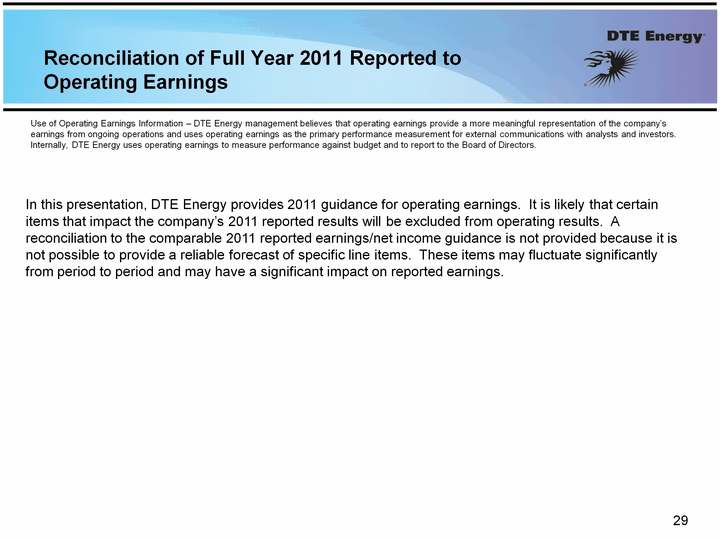
| 29 Reconciliation of Full Year 2011 Reported to Operating Earnings Use of Operating Earnings Information - DTE Energy management believes that operating earnings provide a more meaningful representation of the company's earnings from ongoing operations and uses operating earnings as the primary performance measurement for external communications with analysts and investors. Internally, DTE Energy uses operating earnings to measure performance against budget and to report to the Board of Directors. In this presentation, DTE Energy provides 2011 guidance for operating earnings. It is likely that certain items that impact the company's 2011 reported results will be excluded from operating results. A reconciliation to the comparable 2011 reported earnings/net income guidance is not provided because it is not possible to provide a reliable forecast of specific line items. These items may fluctuate significantly from period to period and may have a significant impact on reported earnings. |
